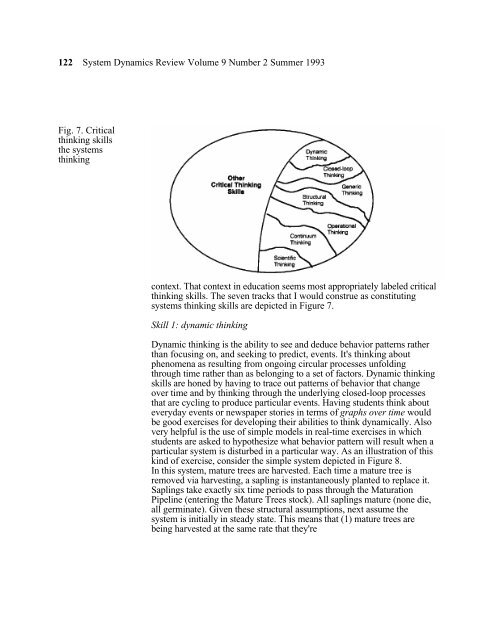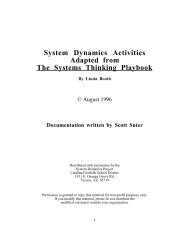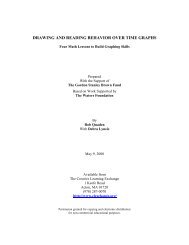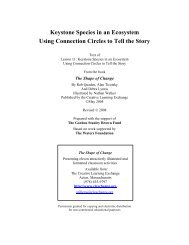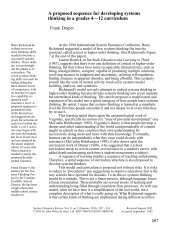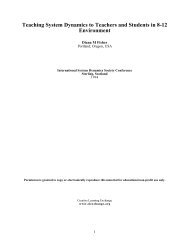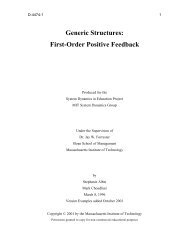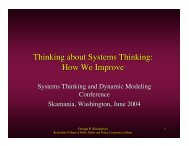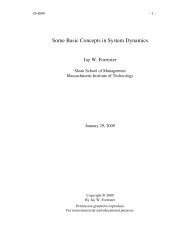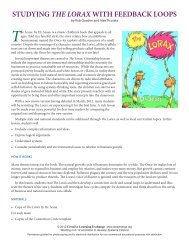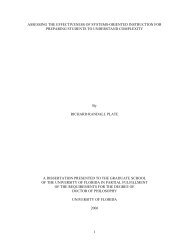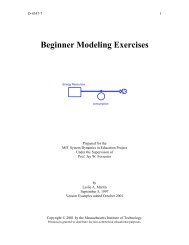Systems thinking: critical thinking skills for the 1990s and beyond
Systems thinking: critical thinking skills for the 1990s and beyond
Systems thinking: critical thinking skills for the 1990s and beyond
- No tags were found...
You also want an ePaper? Increase the reach of your titles
YUMPU automatically turns print PDFs into web optimized ePapers that Google loves.
122 System Dynamics Review Volume 9 Number 2 Summer 1993Fig. 7. Critical<strong>thinking</strong> <strong>skills</strong><strong>the</strong> systems<strong>thinking</strong>context. That context in education seems most appropriately labeled <strong>critical</strong><strong>thinking</strong> <strong>skills</strong>. The seven tracks that I would construe as constitutingsystems <strong>thinking</strong> <strong>skills</strong> are depicted in Figure 7.Skill 1: dynamic <strong>thinking</strong>Dynamic <strong>thinking</strong> is <strong>the</strong> ability to see <strong>and</strong> deduce behavior patterns ra<strong>the</strong>rthan focusing on, <strong>and</strong> seeking to predict, events. It's <strong>thinking</strong> aboutphenomena as resulting from ongoing circular processes unfoldingthrough time ra<strong>the</strong>r than as belonging to a set of factors. Dynamic <strong>thinking</strong><strong>skills</strong> are honed by having to trace out patterns of behavior that changeover time <strong>and</strong> by <strong>thinking</strong> through <strong>the</strong> underlying closed-loop processesthat are cycling to produce particular events. Having students think abouteveryday events or newspaper stories in terms of graphs over time wouldbe good exercises <strong>for</strong> developing <strong>the</strong>ir abilities to think dynamically. Alsovery helpful is <strong>the</strong> use of simple models in real-time exercises in whichstudents are asked to hypo<strong>the</strong>size what behavior pattern will result when aparticular system is disturbed in a particular way. As an illustration of thiskind of exercise, consider <strong>the</strong> simple system depicted in Figure 8.In this system, mature trees are harvested. Each time a mature tree isremoved via harvesting, a sapling is instantaneously planted to replace it.Saplings take exactly six time periods to pass through <strong>the</strong> MaturationPipeline (entering <strong>the</strong> Mature Trees stock). All saplings mature (none die,all germinate). Given <strong>the</strong>se structural assumptions, next assume <strong>the</strong>system is initially in steady state. This means that (1) mature trees arebeing harvested at <strong>the</strong> same rate that <strong>the</strong>y're


